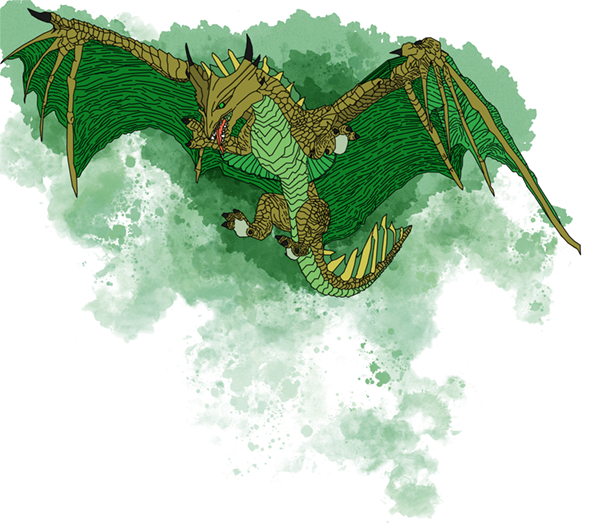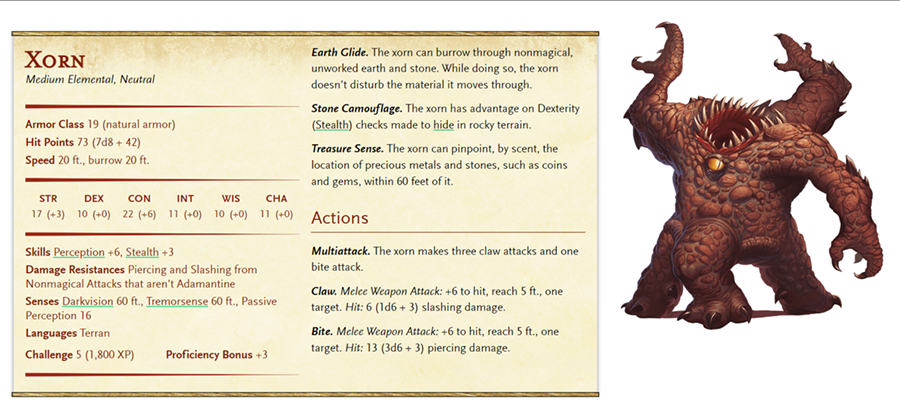Monsters
Monsters are any creature your player's character has to fight or at least interact with in an adventure. DnD currently has over 2k monsters conveniently categorized into 14 types.
The 14 types of monsters:
- Aberration
- Beast
- Celestial
- Construct
- Dragon
- Elemental
- Fey
- Fiend
- Giant
- Humanoid
- Monstrosity
- Ooze
- Plant
- Undead
Many of these monsters were taken from or inspired by actual myths and legends from the real world, such as dragons, ghosts, Minotaurs, trolls, golems, and even Medusa for example.
A Typical Encounter
There are 4 players (4 characters). The DM has been designing the next portion of an adventure of his most recent campaign. The players and the DM sit down at Player 1's house for their weekly session. There's a 30in x 30in vinyl "battle map" on the table before them. Each player has their character sheet, mini (1-inch plastic miniature of their character), a 7-set DnD dice set, and a pencil. The DM hides himself behind a "DM screen" (D&D - decorated piece of cardboard). Among all the players are also the Players Handbook and the Monster Manual. The DM has a notebook for keeping track of the story and other notes...
Player 2: "We go to the nearest tavern."
DM: "Ok. You guys are in the tavern. What now?"
It is at this point that all the players will roll their d20 (20-sided die) and add their "initiative" score that's on their character sheet for their final score. The DM rolls initiative for the half-orc. The rolls determine the play order of the characters.
DM: rolls "to hit" for his half-orc (his total = 14)
DM: "Does a 14 hit?"
Player 3: "Nope!"
DM: looks to Player 4, "Your turn."
The game continues until ultimately the half-orc is either knocked out (0 hit points) or dead. These fighting encounters are rarely every played any other way. At the end of the fight the players, (if they remember 😉), search the incompacitated/dead opponents for any items or gear.
The fight is now over and the half-orc is dead.
Dungeons
Dungeons in DnD can be as simple or as complex as your DM wants them to be. Like the actual adventures, they can choose to create one themselves or take one from a module. As you can see from above, encounters can happen anywhere apart from an actual dungeon, be it in an inn, the plains and fields, a gloomy and dense forest, on another plane, and more.
There are a lot of popular dungeon map creation platforms online. Some are simple and free while others require a download. Here is a list of recommended ones: arcaneeye.com
The History
Dungeons & Dragons (DnD) is a co-operative, tabletop role-playing game or more commonly referred to as a "TTRPG". Originally designed by Gary Gygax and Dave Arneson in 1974, this game is still going strong. It's undeniable how many movies, video games, board games, and more have been influenced by DnD. DnD itself has handbooks, gaming supplies, magazines, animations, movies, video games, cards, fiction book series, comics, toys, and even a music soundtrack.

Put as simply as possible: it's a storytelling game in which you create a "character", play with other people and their characters in a world with problems to solve, monsters to slay, and more tasks. The DnD publishers give you all the rules of play and content you'd need to run your game (another name for a single DnD game is "campaign"). It's a creative game in which you can change almost anything you want, afterall it's story-telling.
Over the years, several companies had the rights to DnD and over the years these companies changed their licensing, to an Open Game License (OGL) from a Game System License and then back again. Homebrew is unlicensed content for DnD (races, monsters, backgrounds, classes, spells, etc.) created by the players themselves. Without the Open Game License (OGL), Homebrew would either be prohibited or the content creators would have to sell at the least a small amount of the rights to thier unlicensed material to the DnD publishers. These small content creators would suffer and so would the DnD community.
To see a player community of Homebrew items check out DnDBeyond. You can submit your own Homebrew or use some of the thousands on content already on the site in your campaign.
Publishers
- Tactical Studies Rules, Inc. (TSR) (1974)
- Wizards of the Coast (WotC) (1997)
- Wizards of the Coast - as a subsidiary to Hasbro (1999)
Editions
- Original (introduced rules that would become the standard in later editions) (1974)
- Basic Set 1st version - "1e" (1977)
- Advanced D&D (1977)
- Basic Set 2nd version (1981)
- Basic Set 3rd version (1983)
- Advanced D&D 2nd Edition - "2e" (1989)
- Rules Cyclopedia (1991)
- 3rd edition - "3e" (2000)
- v.3.5 (revised version of the 3rd edition) (2003)
- 4th edition - "4e" (2008)
- 5th edition - "5e" (2014)
- 5th edition - "5e" Revised - (2024)
In 2000, under the Open Game License (OGL), the System Reference Document (SRD) was published. It is a reference
for a role-playing game's mechanics that allow other publishers to make compatible material for their games. You can find the actual document(s)
on WotC's Dungeons & Dragons site:
resources/systems-reference-document
There are three books that were published from 1977-1979 (referred to as "core rulebooks") that have gone through some upgrades and changes over the years but nevertheless remain a must-have on the shelves of devoted DnD gamers: Monster Manual (1977), the Player's Handbook (1978), and the Dungeon Master's Guide (1979)

Original Monster Manual (1977)

5e Monster Manual (2014)
Comparable TTRPGs
Star Wars Roleplaying Game
2000
The game was first published by WotC and is currently out of print, however, the game (of the same title) bounced from a few publishing companies and is currently being published by Edge Studio.
Their game themes include Star Wars: Edge of the Empire, Star Wars: Age of Rebellion, and Star Wars: Force and Destiny, just to name a few. Players can play as bounty hunters, colonists, explorers, hired guns, Jedi, and more.
Pathfinder Roleplaying Game (Pathfinder)
2009
In 2002, under contract from DnD publishers Wizards of the Coast, the company Paizo took over publishing DnD's Dragon and Dungeon magazines. Five years later, WotC chose not to renew this contract, so Paizo chose to publish the magazine Pathfinder as a replacement. Unsatisfied with WotC's stricter game license of their 4th edition, Paizo chose to make their own TTRPG, the Pathfinder Roleplaying Game, using DnD's v.3.5 (nicknamed D&D version 3.75). There were, however, some changes made to the game mechanics. The Pathfinder TTRPG remains popular to this day, having a large collection of its own handbooks, video games, cards, fiction book series, and a large online community.
paizo.com/pathfinderStarfinder Roleplaying Game (Starfinder)
2017
In 2017 Paizo released their science fiction equivalent to the Pathfinder Roleplaying Game, the Starfinder Roleplaying Game. The game mechanics as well as the world setting are the same as Pathfinder.


